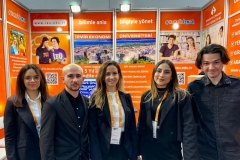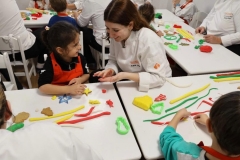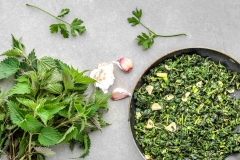
SCHOOL OF APPLIED MANAGEMENT SCIENCES
Gastronomy and Culinary Arts Program
GEIN 316 | Course Introduction and Application Information
| Course Name |
Innovative Design Strategies
|
|
Code
|
Semester
|
Theory
(hour/week) |
Application/Lab
(hour/week) |
Local Credits
|
ECTS
|
|
GEIN 316
|
Fall/Spring
|
2
|
2
|
3
|
4
|
| Prerequisites |
None
|
|||||
| Course Language |
English
|
|||||
| Course Type |
Service Course
|
|||||
| Course Level |
First Cycle
|
|||||
| Mode of Delivery | - | |||||
| Teaching Methods and Techniques of the Course | DiscussionGroup WorkProblem SolvingCase StudyLecture / Presentation | |||||
| Course Coordinator | ||||||
| Course Lecturer(s) | ||||||
| Assistant(s) | - | |||||
| Course Objectives | This course aims to expose students to design processes and methods for innovative new product development. Students will engage in strategic thinking and research into, for example, the political, economic, social and technological contexts of new products, services or systems. As the outcome of the course, students will propose product concepts and product specifications that are intended for further development. |
| Learning Outcomes |
The students who succeeded in this course;
|
| Course Description | This course will consist of design problems concentrating particularly on the early phases of new product development. Students will work individually or in groups and proceed in stages along a new product development process. They will employ a number of tasks including planning, creative thinking, desk and field research, product concept design, design concept development, preparing and making presentations, and composing business proposals. At the end of the course, students will produce an innovative product concept. |
|
|
Core Courses | |
| Major Area Courses | ||
| Supportive Courses | ||
| Media and Management Skills Courses | ||
| Transferable Skill Courses |
WEEKLY SUBJECTS AND RELATED PREPARATION STUDIES
| Week | Subjects | Related Preparation |
| 1 | INTRODUCTION - Course Introduction and Overview - “Design Ladder” | Syllabus |
| 2 | THE CREATIVE ECONOMY AND DESIGN THINKING - Creative Economy and Today - Introduction to Design Thinking - On Human Creativity - General Principles of Service Design | Reading: Tim Brown (2008). Design thinking. Harvard Business Review, 86(6), 84-92. |
| 3 | THE CREATIVE ECONOMY AND DESIGN THINKING - Creative Economy and Today - Introduction to Design Thinking - On Human Creativity - General Principles of Service Design | Homework: Video & Essay on ‘What we’ve learnt’ |
| 4 | DESIGN STRATEGIES: Design Strategies Case Studies - What is Strategy? - What is Strategic design? | Reading: Rohan Doherty, Cara Wrigley, Judy Matthews, and Sam Bucolo (2014). Climbing the design ladder: Step by step. In Proceedings of the 19th DMI Academic Design Management Conference, London, pp. 2578-2600. & Homework submission |
| 5 | DESIGN STRATEGIES: Strategic Design Practice - How to Translate Strategy to Design - Changing Roles of Designers - Discussions: Success Stories on Service Design Strategies | Reading: Rohan Doherty, Cara Wrigley, Judy Matthews, and Sam Bucolo (2014). Climbing the design ladder: Step by step. In Proceedings of the 19th DMI Academic Design Management Conference, London, pp. 2578-2600. PRESENTATION 1 Brief |
| 6 | DESIGN STRATEGIES Presentation: Success Stories on Service Design Strategies | SUBMISSION REQUIREMENTS & PRESENTATION |
| 7 | DESIGN STRATEGIES Presentation: Success Stories on Service Design Strategies (cont.) | PRESENTATION |
| 8 | DESIGN STRATEGIES Presentation: Success Stories on Service Design Strategies (cont.) | PRESENTATION |
| 9 | LIVE OR DIE: INNOVATIVE IDEA FAILURES - Idea Failures Case Studies - Distribution of Presentation 2 Subjects and Student Groups: Creative/Innovative Communications - “Brand Positioning” Analysis Example (Video Screening) | Reading: Michael B. Beverland and Francis J. Farrelly (2010). What does it mean to be design-led? Design Management Review, 18(4), 10-17. |
| 10 | Discussions: Designing Creative & Innovative Communications for Global Issues | PROJECT Brief |
| 11 | CREATIVE EXPERIENCES: Designing Creative & Innovative Communications for Global Issues - In-class Study: System Map & User Journey Map | Ecosystem Map & User Journey Map |
| 12 | DESIGN STRATEGIES Project: Designing Creative & Innovative Communications for Global Issues | SUBMISSION REQUIREMENTS & PROJECT |
| 13 | DESIGN STRATEGIES Project: Designing Creative & Innovative Communications for Global Issues (cont.) | PROJECT |
| 14 | DESIGN STRATEGIES Project: Designing Creative & Innovative Communications for Global Issues (cont.) | PROJECT |
| 15 | Review of the Semester | None |
| 16 | Review of the Semester | None |
| Course Notes/Textbooks | - |
| Suggested Readings/Materials | Bruce, Margaret and J R Bessant. 2002. Design in Business : Strategic Innovation Through Design. Harlow, England ; London ; New York: Financial Times/Prentice Hall.Keinonen, Turkka and Roope Takala. 2006. Product Concept Design : A Review of the Conceptual Design of Products in Industry. New York]: Springer.Kelley, Tom and Jonathan Littman. 2001. The Art of Innovation : Lessons in Creativity From IDEO, America's Leading Design Firm. New York: Currency/Doubleday.Riley, Patrick G. 2002. The OnePage Proposal : How to Get Your Business Pitch Onto One Persuasive Page. New York: ReganBooks.Schifferstein, H and Paul, Hekkert. 2008. Product Experience. San Diego, CA: Elsevier.Snyder, Carolyn. 2003. Paper Prototyping: The Fast and Easy Way to Design and Refine User Interfaces. San Francisco: Morgan Kaufmann Publishers.Squires, Susan and Bryan Byrne. 2002. Creating Breakthrough Ideas : The Collaboration of Anthropologists and Designers in the Product Development Industry. Westport, CT: Bergin & Garvey.Stanton, Neville. 2005. Handbook of Human Factors and Ergonomics Methods. Boca Raton: CRC Press.Suri, Jane Fulton and Matthew Marsh. 2000. “Scenario Building as an Ergonomics Method in Consumer Product Design.” Applied Ergonomics, vol. 31:151157. Elsevier Science Ltd.Van der Heijden, Kees. 2005. Scenarios : The Art of Strategic Conversation. Chichester, West Sussex ; Hoboken, N.J.: John Wiley & Sons. |
EVALUATION SYSTEM
| Semester Activities | Number | Weigthing |
| Participation |
1
|
10
|
| Laboratory / Application | ||
| Field Work | ||
| Quizzes / Studio Critiques | ||
| Portfolio | ||
| Homework / Assignments |
1
|
20
|
| Presentation / Jury |
1
|
40
|
| Project |
1
|
30
|
| Seminar / Workshop | ||
| Oral Exams | ||
| Midterm | ||
| Final Exam | ||
| Total |
| Weighting of Semester Activities on the Final Grade |
4
|
100
|
| Weighting of End-of-Semester Activities on the Final Grade | ||
| Total |
ECTS / WORKLOAD TABLE
| Semester Activities | Number | Duration (Hours) | Workload |
|---|---|---|---|
| Theoretical Course Hours (Including exam week: 16 x total hours) |
16
|
2
|
32
|
| Laboratory / Application Hours (Including exam week: '.16.' x total hours) |
16
|
2
|
32
|
| Study Hours Out of Class |
0
|
||
| Field Work |
0
|
||
| Quizzes / Studio Critiques |
0
|
||
| Portfolio |
0
|
||
| Homework / Assignments |
1
|
6
|
6
|
| Presentation / Jury |
1
|
20
|
20
|
| Project |
1
|
20
|
20
|
| Seminar / Workshop |
0
|
||
| Oral Exam |
0
|
||
| Midterms |
0
|
||
| Final Exam |
0
|
||
| Total |
110
|
COURSE LEARNING OUTCOMES AND PROGRAM QUALIFICATIONS RELATIONSHIP
|
#
|
Program Competencies/Outcomes |
* Contribution Level
|
||||
|
1
|
2
|
3
|
4
|
5
|
||
| 1 | Successfully applies theoretical and practical knowledge and skills in Gastronomy and Culinary Arts |
|||||
| 2 | Carries best practices in terms of work and food security, safety and hygiene in food production |
|||||
| 3 | Appreciates, evaluates and makes decisions regarding to visual, textual and nutritional data with respect to food production and presentation |
|||||
| 4 | Recognizes and evaluates the impact of gastronomy on culture and society |
|||||
| 5 | Assumes responsibility for solving complex problems that may occur in the field of Gastronomy and Culinary Arts, both individually and as a team member |
|||||
| 6 | Evaluates the knowledge and skills acquired in the field of Gastronomy and Culinary Arts with a critical approach and effectively communicate their ideas and suggestions for solutions in written and oral form. |
|||||
| 7 | Possesses necessary knowledge and skills in relevant fields such as gastronomy, design, law and management and effectively apply them to the practice of Culinary Arts |
|||||
| 8 | Uses the technological tools related to Gastronomy and Culinary Arts effectively |
|||||
| 9 | Updates and improve the knowledge, skills and competencies related to Gastronomy and Culinary Arts with lifelong learning awareness and sustainability with an ethical approach |
|||||
| 10 | Collects data in the areas of Gastronomy and Culinary Arts and communicate with colleagues in a foreign language. (European Language Portfolio Global Scale”, Level B1) |
|||||
| 11 | Speaks a second foreign at a medium level of fluency efficiently |
|||||
| 12 | Relates the knowledge gained through the history of humanity to the field of expertise |
|||||
*1 Lowest, 2 Low, 3 Average, 4 High, 5 Highest
NEWS |ALL NEWS

Aegean flavors from the chefs of the future
Izmir University of Economics (IUE) Department of Gastronomy and Culinary Arts left its mark on the 6th Izmir GastroFest, organized this year with
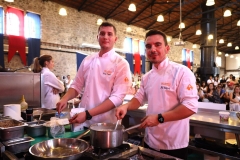
They added flavor to GURMEFEST
GURMEFEST, one of the biggest food, drink and entertainment festivals of Izmir, was ‘flavored’ with the dishes prepared and presented by the
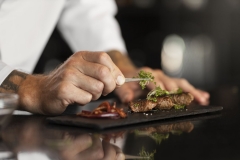
“Izmir and Bodrum will class up”
The MICHELIN Guide, one of the most prestigious restaurant rating systems in the world, has added Izmir and Bodrum to its Turkish
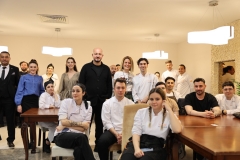
IUE graduates will prepare the flavors unique to Turkish cuisine
Bilsev Group, who is preparing to expand to Dubai this year with its Ferdi Baba, Fabrice Restaurant and Baba Pizza brands, will
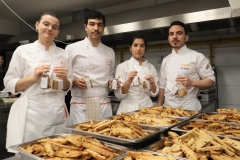
They prepared products that are filling and have a long shelf life
25 students of Department of Gastronomy and Culinary Arts of Izmir University of Economics (IUE) prepared products with a long shelf life,



